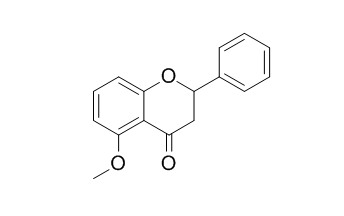5-Methoxyflavanone
5-Methoxyflavone shows antioxidant and suppressive activity on the production of nitric oxide (NO) from lipopolysaccharide (LPS)-induced macrophage cells. It provides gastroprotection against nonsteroidal anti-inflammatory drug-induced gastric damage. 5-Methoxyflavanone induces cell cycle arrest at the G2/M phase, apoptosis and autophagy in HCT116 human colon cancer cells.
Inquire / Order:
manager@chemfaces.com
Technical Inquiries:
service@chemfaces.com
Tel:
+86-27-84237783
Fax:
+86-27-84254680
Address:
1 Building, No. 83, CheCheng Rd., Wuhan Economic and Technological Development Zone, Wuhan, Hubei 430056, PRC
Providing storage is as stated on the product vial and the vial is kept tightly sealed, the product can be stored for up to
24 months(2-8C).
Wherever possible, you should prepare and use solutions on the same day. However, if you need to make up stock solutions in advance, we recommend that you store the solution as aliquots in tightly sealed vials at -20C. Generally, these will be useable for up to two weeks. Before use, and prior to opening the vial we recommend that you allow your product to equilibrate to room temperature for at least 1 hour.
Need more advice on solubility, usage and handling? Please email to: service@chemfaces.com
The packaging of the product may have turned upside down during transportation, resulting in the natural compounds adhering to the neck or cap of the vial. take the vial out of its packaging and gently shake to let the compounds fall to the bottom of the vial. for liquid products, centrifuge at 200-500 RPM to gather the liquid at the bottom of the vial. try to avoid loss or contamination during handling.
Int J Mol Sci.2023, 24(18):13713.
Dent Mater J. 2024, dmj.2023-294.
Psychopharmacology (Berl).2020, 10.1007
Arch Biochem Biophys.2020, 687:108363.
Plant Cell Tiss Org2020, 1-16
The Journal of Korean Medicine2022, 43(3): 79-93.
Molecules.2024, 29(5):1048.
Phytomedicine.2017, 24:77-86
Research on Crops.2017, 18(3):569
Research Square2023, 2883170.
Related and Featured Products
Food Bioscience, 2015,11(5):1-7.
In-vitro evaluation for antioxidant and anti-inflammatory property of flavanone derivatives.[Reference:
WebLink]
The purpose of this study is to evaluate the antioxidant and suppressive activity of flavanone derivatives on the production of nitric oxide (NO) from lipopolysaccharide (LPS)-induced macrophage cells.
METHODS AND RESULTS:
Flavanone derivatives were prepared by adding one to three methoxy substituents (–OCH3) to flavanone or chloroflavanone structure. 5-Methoxyflavanones, including 5-Methoxyflavanone, 5-methoxy-4′-chloroflavanone, and 5,4′-dimethoxyflavanone, had the best antioxidant activity, as compared to other flavanone derivatives. Anti-inflammatory effect of flavanone derivatives was studied by suppressive activity on NO synthesis from LPS-stimulated macrophages cells. 3′,4′-Dimethoxyflavanone, 5-Methoxyflavanone, and 5-methoxy-4′-chloroflavanone showed the potent inhibitory activity on nitrite production. Addition of the methoxy group at 5′-position and 3′,4′-position of flavanone showed a high inhibitory activity of NO production from LPS-macrophage cells, which is one of the typical anti-inflammatory biomarkers.
CONCLUSIONS:
Taken together, the location of the methoxy group in a flavanone structure might have some connection with antioxidant and anti-inflammatory activities.
Digestion, 1997, 58(2):147-154.
Flavonoid-lnduced Gastroprotection in Rats: Role of Blood Flow and Leukocyte Adherence.[Reference:
WebLink]
To elucidate the mechanisms of flavonoid-induced protection against nonsteroidal anti-inflammatory drug (indomethacin)-induced acute gastric damage, the effects of 5-methoxyflavone and 5-Methoxyflavanone on the gastric vasculature were compared both in vivo (using laser Doppler flowmetry in anesthetized rats) and in vitro on rat superior mesenteric arteries.
METHODS AND RESULTS:
The effects of the compounds on indomethacin-induced leukocyte adherence to mesenteric venules were investigated by intravital videomicroscopy. Oral 5-methoxyflavone reduced indomethacin-induced macroscopic damage by 38 to 99% (ED50 = 5.5 mg/kg). Damage was not significantly reduced by 5-Methoxyflavanone. Light microscopy studies also demonstrated a reduction in damage severity. 5-Methoxyflavone, but not 5-Methoxyflavanone, increased the gastric conductance significantly. The effects on isolated mesenteric arteries correlated with the effects on in vivo conductance. Finally, indomethacin-induced leukocyte adherence was inhibited to a greater extent by 5-methoxyflavone than by 5-Methoxyflavanone.
CONCLUSIONS:
In conclusion, the flavonoid 5-methoxyflavone provides gastroprotection against nonsteroidal anti-inflammatory drug-induced gastric damage. A structurally similar compound, 5-Methoxyflavanone, demonstrated minimal gastroprotective activity, suggesting that the double bond of 5-methoxyflavone is required for biological activity. The finding that 5-methoxyflavone (but not 5-Methoxyflavanone) significantly increased gastric vascular perfusion and reduced leukocyte adherence to mesenteric venules suggests that these mechanisms may contribute to the flavonoid's gastroprotective activity.
Toxicology & applied pharmacology, 2011, 254(3):288-298.
5-Methoxyflavanone induces cell cycle arrest at the G2/M phase, apoptosis and autophagy in HCT116 human colon cancer cells.[Reference:
WebLink]
Natural flavonoids have diverse pharmacological activities, including anti-oxidative, anti-inflammatory, and anti-cancer activities.
METHODS AND RESULTS:
In this study, we investigated the molecular mechanism underlying the action of 5-Methoxyflavanone (5-MF) which has a strong bioavailability and metabolic stability. Our results show that 5-MF inhibited the growth and clonogenicity of HCT116 human colon cancer cells, and that it activated DNA damage responses, as revealed by the accumulation of p53 and the phosphorylation of DNA damage-sensitive proteins, including ataxia–telangiectasia mutated (ATM) at Ser1981, checkpoint kinase 2 (Chk2) at Thr68, and histone H2AX at Ser139. 5-MF-induced DNA damage was confirmed in a comet tail assay. We also found that 5-MF increased the cleavage of caspase-2 and -7, leading to the induction of apoptosis. Pretreatment with the ATM inhibitor KU55933 enhanced 5-MF-induced γ-H2AX formation and caspase-7 cleavage. HCT116 cells lacking p53 (p53−/−) or p21 (p21−/−) exhibited increased sensitivity to 5-MF compared to wild-type cells. 5-MF further induced autophagy via an ERK signaling pathway. Blockage of autophagy with the MEK inhibitor U0126 potentiated 5-MF-induced γ-H2AX formation and caspase-2 activation.
CONCLUSIONS:
These results suggest that a caspase-2 cascade mediates 5-MF-induced anti-tumor activity, while an ATM/Chk2/p53/p21 checkpoint pathway and ERK-mediated autophagy act as a survival program to block caspase-2-mediated apoptosis induced by 5-MF.
Natural Product Research, 2009, 23(13):1231-1239.
Microbial metabolism. Part 10: Metabolites of 7,8-dimethoxyflavone and 5-methoxyflavone.[Reference:
WebLink]
METHODS AND RESULTS:
Microbial transformation of 7,8-dimethoxyflavone (1) by Mucor ramannianus produced five metabolites: 7,8-dimethoxy-4′-hydroxyflavone (2), 3′,4′-dihydroxy-7,8-dimethoxyflavone (3), 7,3′-dihydroxy-8-methoxyflavone (4), 7,4′-dihydroxy-8-methoxyflavone (5) and 8-methoxy-7,3′,4′-trihydroxyflavone (6). It was, however, completely converted to a single metabolite, 7-hydroxy-8-methoxyflavone (7) by Aspergillus flavus. 5-Methoxyflavone (8), when fermented with Beauveria bassiana, gave a single product, 5-Methoxyflavanone (9). Conversion of 8 with Aspergillus alliaceus yielded the metabolite 4′-hydroxy-5-methoxyflavone (10). The structures of the compounds 2–7, 9 and 10 were established by spectroscopic methods.



